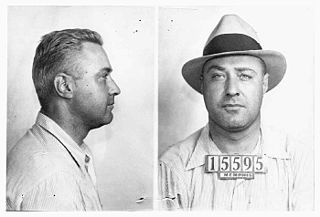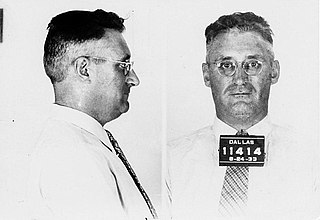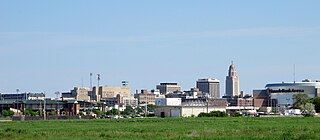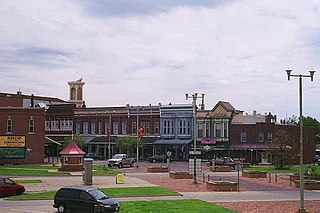
Kate Barker, better known as Ma Barker and sometimes as Arizona Barker, was the mother of several American criminals who ran the Barker-Karpis gang during the "public enemy era" when the exploits of gangs of criminals in the Midwest gripped the American people and press. She traveled with her sons during their criminal careers.

John Paul Chase was an American bank robber and Depression-era outlaw. He was a longtime criminal associate of the Karpis-Barker Gang and most notably Baby Face Nelson who later brought him into the John Dillinger gang. FBI Director J. Edgar Hoover once referred to Chase as "a rat with a patriotic-sounding name". Chase and Nelson continued to rob banks with John Dillinger until Dillinger's death in July 1934. After the death of Nelson in November 1934, Chase fled back to California where he was arrested a month later on December 27, 1934. Chase was sent to Alcatraz where he became one of the longest-serving inmates;.
Robert G. "Big Bob" Brady was an American bank robber and Depression-era outlaw. A well-known Oklahoma bandit during the 1920s and 1930s, Brady was associated with Wilbur Underhill, Harvey Bailey and Jim Clark.
Jim Clark was an American bank robber and Depression-era outlaw. A longtime career criminal in Oklahoma during the 1920s, Clark was associated with Wilbur Underhill, Harvey Bailey and Robert "Big Bob" Brady and remained a public enemy in the state of Kansas until his capture and imprisonment in 1934.
The Cretzer-Kyle Gang was a Depression-era criminal group led by Joseph "Dutch" Cretzer and Arnold Thomas Kyle during the mid-to late 1930s. Largely active in the West Coast, they were one of the few groups to gain national attention outside the Midwest and also one of the last groups to be captured by the FBI at the end of the decade. Cretzer was killed in a failed attempt to escape Alcatraz resulting in the 1946 prison riot.

Volney Everett "Curley" Davis was an American bank robber and Depression-era outlaw. A longtime Oklahoma bandit, he was the boyfriend of Edna Murray and an associate of both the John Dillinger and Alvin Karpis-Barker gangs during the 1930s.
Lawrence DeVol was an American criminal, bank robber, prison escapee and Depression-era outlaw. He was connected to several Midwestern gangs during the 1920s and 1930s, most often with the Barker-Alvin Karpis and Holden-Keating Gangs, and was also a former partner of Harvey Bailey early in his criminal career. DeVol is known to have killed at least eleven people during his criminal career, including six law enforcement officers.
Russell "Slim Gray" Gibson was an American bank robber and Depression-era outlaw associated with Alvin Karpis and the Barker Gang during the late 1920s and 1930s. Gibson spent much of his early criminal career with the Central Park Gang based in Tulsa, Oklahoma which included the Barkers, Volney Davis, Ray Terrill and other local criminal figures. He participated in his first major robbery when he teamed with Neal Merritt and James "Cowboy" Long to rob a bank messenger in Oklahoma City of $75,000. Gibson was arrested for this robbery but escaped from county jail prior to his trial.

Harold Eugene "Eddie" Green was an American bank robber and Depression-era outlaw during the 1930s, best known as a member of the John Dillinger gang. He was also associated with Frank "Jelly" Nash, Volney Davis and the Barker-Karpis Gang in his early career.

Herbert Allen Farmer, was an American criminal who, with his wife Esther, operated a safe house for underworld fugitives from the mid-1920s to 1933.
Frederick Grant Dunn (1905–1959) was an American criminal, burglar and bank robber whose career spanned over four decades from 1919 until his mysterious death in 1959. He led a small gang during the 1940s and 1950s, Dunn becoming referred to by the press as "the modern John Dillinger", and whose activities eventually resulted in his being listed on the FBI's Ten Most Wanted in 1958.

Frederick George Barker (1901–1935) was one of the founders of the Barker-Karpis gang, which committed numerous robberies, murders and kidnappings during the 1930s. He was the youngest son of Ma Barker, all of whose children were criminals. He was killed in a lengthy gunfight with the FBI in 1935.
Wilbur Underhill Jr., often called "Mad Dog" or the "Tri-State Terror", was an American criminal, burglar, bank robber and Depression-era outlaw. He was one of the most wanted bandits in Oklahoma during the 1920s and 1930s and co-led a gang with Harvey Bailey that included many fellow Cookson Hills outlaws including Jim Clark, Ed Davis and Robert "Big Bob" Brady.

The Barker–Karpis Gang was one of the longest-lived criminal gangs during the Depression Era, spanning from 1931 to 1935. The gang was founded by Fred Barker and Alvin Karpis, and later joined by Fred's brother Arthur "Doc" Barker. Along with the three core members, the gang's network spanned up to 25 members at one point.
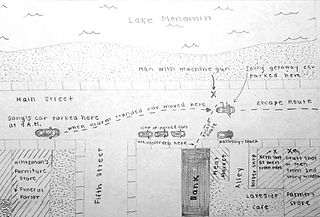
The Kraft State Bank robbery occurred on October 20, 1931 in Menomonie, Wisconsin when Charles Preston Harmon, Frank Webber, Francis Keating and Tommy Holden stole US$90,000 dollars from the Kraft State Bank.

